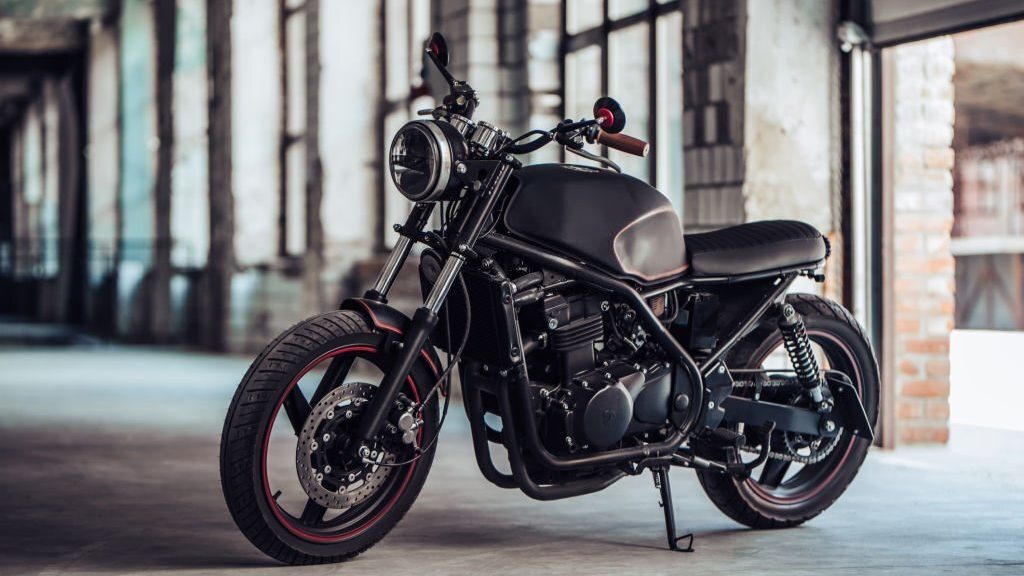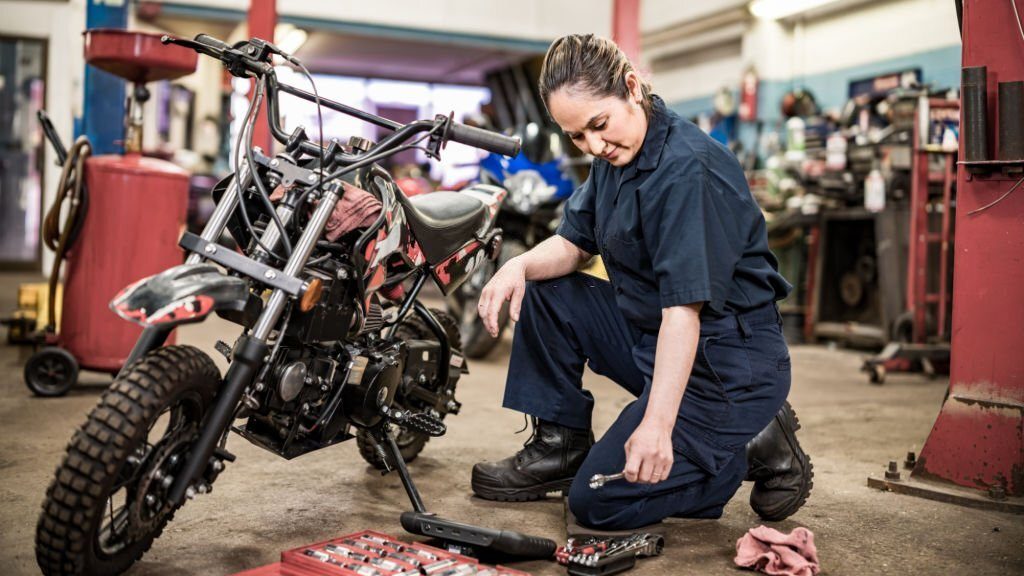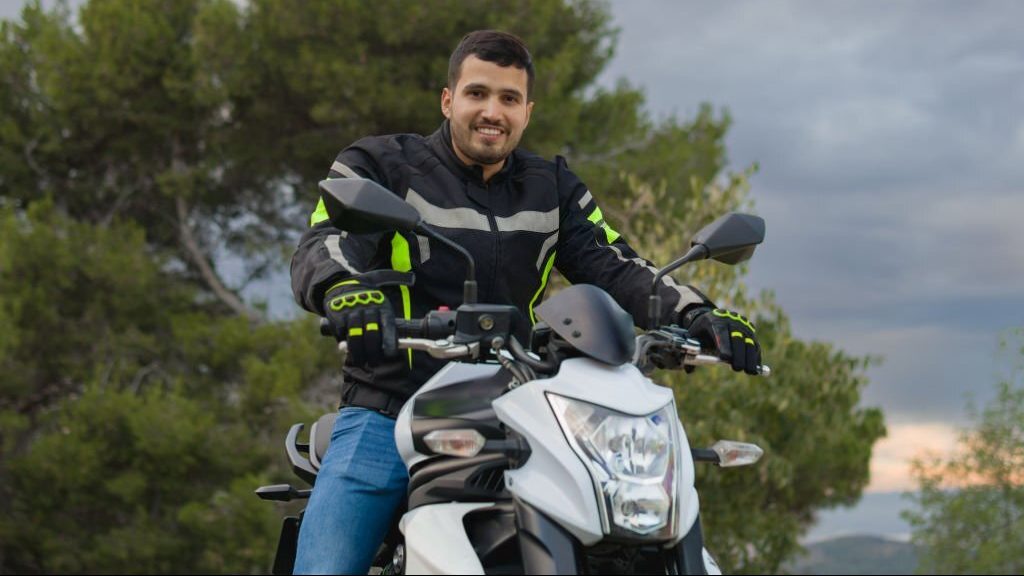It’s important to know a motorcycle’s weight for handling, transportation, and safety reasons.
The weights of the motorcycles vary because different categories meet the needs of various riders.
This article will examine several motorcycle kinds and their normal weights in order to answer the question, “how much do motorcycles weigh?”.

By the time you’ve finished reading this comprehensive guide, you’ll know exactly what to anticipate in terms of motorbike weights and how they could affect your riding experience.
How much do motorcycles weigh?
The weights of different motorcycles can vary depending upon different factors, such as the size of the engine or exhaust, etc.
However, the minimum weight of a motorcycle can go down to 150 pounds, whereas the maximum weight can be more than 1000 pounds.
The most common weight range for most motorcycles is typically between 400 and 800 pounds.
The list of lightest bikes includes;
Bajaj CT 100 (109 kg)
TVS Radeon (118 kg)
Honda Livo (111 kg)
A Harley Davidson weight is 450 to 800+ pounds, keeping the reputation for being one of the heaviest bikes out there.
The average weight of a bike is higher in case of an electric bike compared to a traditional bike due to the weight of the added battery and motor.
Not all bikes are the same
Not all motorcycles are the same, and each type of bike involves different designs and features, which affect its weight.

Most motorcycles weigh between 400-800 pounds on average, but that’s just a broad approximation.
You can tell someone when asked, “how heavy are motorcycles?”
In fact, the weight of a motorcycle is influenced by a number of elements, such as the engine, exhaust, and frame dimensions. Large batteries, powerful brakes, and steel rims can all significantly increase the weight of a bike. The main element is still the engine.
The weight of the engine accounts for a large portion of their differences. You won’t find a 650cc cruiser (very large) that weighs 300 pounds.
Motorcycle Weight By the Types

Chopper
Choppers lead the list of the heaviest motorbikes now on the market as their weight ranges from 500-800 pounds.
This heaviness is a result of the way chopper bikes are built.
Adventure bikes
Apparently, adventure bikes look heavy, but on average, they range from 350-600 pounds.
They aren’t really heavy, depending on their usage requirements. They are also driven off-roads, and off-road bikes should be light and easy to ride.
Dirt bikes
Dirt bikes are considered as one of the lightest motorcycles in the list. Average dirt bike’s weight is 215 pounds.

Dirt bike weight depends upon the size of its engine and is specifically designed for off-road purposes.
This sort of motorbike must have streamlined handling because riders must use it on a variety of surfaces, including sand, dirt, forests, and beaches.
Touring bikes
400 to 1000 pounds is the weight range for touring bikes.
Sports bikes
The average weight range for sports bikes is 280 – 530. They’re not as heavy as they look because they’re required to have greater speed, and weight is an important factor to keep in mind when it comes to speed.
Cafe racers
Cafe racers’ heaviness ranges from 400 to 500 pounds. New models are much lighter compared to the vintage ones.
Scooters
Typically, a scooter weighs 150 to 300 pounds.

Scooters are convenient and easy to maneuver in congested traffic, and they are commonly used for commuting within cities.
Cruisers
As we all know, the weight also relies on the size of motorcycle. Therefore cruiser bikes are typically heavy because of their large size.
The only light cruisers available weigh between 600 and 800 pounds. Yet, because they have different engine sizes, cruiser motorcycles have a wide range of weights.
Baggers
A bagger motorcycle typically is a pretty big road bike with a wind-deflecting structure known as a fairing to reduce drag, plus soft saddlebags or rigid compartments that hold a lot of stuff for long rides.
With the addition of this stuff, the weight of a bagger motorcycle could rise up to 850 pounds.
Naked bikes
Contrary to what many people believe, naked bikes are not just sport bikes without fairings.
The weight of naked bikes, excluding variances and the absence of fairings, ranges from 280 to 530 pounds, which is almost as much as their sportier cousins.
Supermoto
Supermoto measure from 220-320 pounds because they’re dual-purpose and modified dirt bikes.
Dual sports
Dual sport motorcycles typically weigh somewhere between 250 and 370 pounds
Motorcycle wet weight vs dry weight
As a motorcycle rider, have you ever heard of the terms “wet weight” and “dry weight”? Like most users, I’m sure you have no idea what these actually refer to. So what do these words actually mean?

What makes the two different?
The term “dry weight” describes the motorcycle’s weight without any fluids. No gas, oil, coolant, final gear oil, brake fluid, or other fluids are allowed. Actually, it’s the weight of a motorbike once it has been completely completed.
“Wet weight” is the weight of a motorcycle with fluids. The specific meaning of this isn’t usually made apparent by the producers
. In some cases, it is the starting weight of a motorcycle, including gas and all fluids. Other times, it is the motorcycle’s weight with only a quarter tank of gas, no gas at all, or everything but gas and oil.
How to lighten the load?
Following are some of the weight reduction tips and techniques to lighten up your load.
Upgrade to lighter wheels
Lighter wheels can benefit you with greater speed too because there’s less weight to control.
Buy a new battery
Even now, many motorcycles use lead-acid batteries, which are far heavier than necessary. The weight of your motorbike can be drastically reduced by using an aftermarket Lithium-ion battery, which can deliver the same power while weighing only 1/3 as much.
Another easy way to lighten up the load from your motorcycle is to choose a lighter frame made up of carbon or aluminum for your motorcycle.
These three will for sure save you some pounds but try removing unnecessary items that you may be carrying, to further reduce the weight.
Also, check how long do motorcycle tires last.
Factors which affect motorcycle’s weight

Intended use
Each type of motorbike has unique designs and characteristics that influence its weight.
Not all motorcycles are created the same. For instance, an off-road bike often weighs less than a street cruiser since it must overcome more hurdles.
A dirt bike typically weighs under 300 pounds and is equipped to handle difficult terrain without breaking things or dozing off in the mud.
Onboard equipments
A motorcycle with a complete fairing and windscreen will be heavier than one with less glass, fiberglass, and plastic in it. plus Saddlebags can increase the weight or bulk of your riding.
CC’s
A bike with lower CCs (a measure of engine capacity and performance) will have a lower weight and vice versa.
The lowest cc for a motorcycle lies within 500-600 of range.
Average motorcycle weights
The average motorcycle weight can vary depending on the type, model of the motorcycle, size of its engine and its cubic capacity.
Even within a single class, motorcycles can different depending upon these factors.
According to engine size, following are the general weight ranges for motorcycles:
- 900-1100cc weight about 400 to 600 pounds
- <200cc weighs 100 to 200 lbs.
- 1200cc and up weight about 500 to 800 pounds.
- 500-800cc weighs about 400 to 450 pounds.
For most models, the motorcycle weight limit is between 350 and 450 pounds. The carrying capacity is determined by subtracting the bike’s weight from its Gross Vehicle Weight Rating.
Motorcycle weight by bike size
The weight of a motorcycle is also affected by the size of the motorcycle. Generally, smaller bikes are lighter compared to larger ones, but there can be a few exceptions too.

A small motorcycle, for instance, 250 cc dirt bike, weighs around 234 lbs
A cruiser motorcycle (larger), on the other hand, weighs 600 to 800 pounds.
Why does motorcycle weight matter?
The weight of a motorcycle is a very important factor to keep in mind before buying one. Generally, larger bikes tend to be heavier than the smaller ones.
A lighter motorcycle requires less energy to move, which means it can get better gas mileage and cost you less money to fuel.
A lighter bike is also easier to handle, as the heavier the bike is, the more physical power you’ll need to ride it.
Shorter stopping distances and improved braking performance are possible with lighter motorcycles since they need less effort to stop.
Harley Davidson weight
Harley-Davidson continues to hold the title of having the heaviest motorcycles.
The extra components that come with Harley models are mostly to blame for the increased weight of those models.
Harley-Davidson motorcycles typically weigh between 450 to 800+ pounds or more.
While cruisers, touring cycles, and baggers make up the majority of their best-selling models, the class already qualifies them as being on the heavier side.
How much do motorcycles weigh FAQs
The weight of a 1000cc motorcycle can vary greatly depending on the make and model of the motorcycle. However, generally speaking, a 1000cc motorcycle weighs between 400 to 600 pounds (181 to 272 kilograms)
A standard street bike from Honda, for example, can weigh anywhere from 348 pounds (the Honda CB300F with a 286cc engine) to 540 pounds (the Honda CB1100 with a 1140cc engine).
Before progressing to larger bikes, it’s typically advised for beginners to start with a smaller bike, like a 250cc or 300cc motorbike, to learn the fundamentals of riding.
Your physical size and strength, the motorbike’s intended function, and, to some extent, your riding experience all play a role in determining the size of the motorcycle you need.
You should be able to comfortably reach the ground with both feet while seated on the motorcycle.
A smaller bike can be adequate if you intend to use it exclusively for short trips around the city or for commuting.
Any motorcycle that weighs more than 600 pounds is considered a heavy motorcycle.
No, 500 lbs for a motorcycle is not heavy but lies in the middleweight class range i.e, 400-600 pounds.
125cc motorcycles, for example, the A1 bikes, weigh between 200-250 pounds.
Yes, 650 lbs for a motorcycle is heavy. Generally speaking, a motorcycle that weighs more than 600 pounds is considered to be a heavy motorcycle.
The 450cc class is mainly dominated by lightweight dirt bikes weighing around 200-250 pounds.
Conclusion
To wrap it up, it is important to keep in mind the weight of a motorcycle when considering purchasing one, as it can affect the handling and maneuverability of the bike.
The weight of a motorcycle can vary greatly depending on various factors such as the type, size, and the way it is built.
For new riders, the weight of the motorbike might be very daunting, but as you develop confidence, it becomes less important.
A skilled rider who is familiar with the balance of his or her motorbike won’t even notice the weight.
So, next time you’re shopping for a motorcycle, be sure to take its weight into account and ride safe!


Comments are closed.